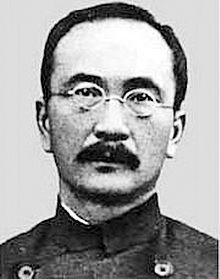Tang Shaoyi
This articleneeds additional citations forverification.(July 2013) |
| |||||||||||||||
|---|---|---|---|---|---|---|---|---|---|---|---|---|---|---|---|
 | |||||||||||||||
| 1stPremier of the Republic of China | |||||||||||||||
| In office 5 August 1922 – 19 September 1922 | |||||||||||||||
| President | Li Yuanhong | ||||||||||||||
| Preceded by | Yan Huiqing | ||||||||||||||
| Succeeded by | Wang Chonghui | ||||||||||||||
| In office 13 March 1912 – 27 June 1912 | |||||||||||||||
| President | Yuan Shikai | ||||||||||||||
| Preceded by | Position established | ||||||||||||||
| Succeeded by | Lu Zhengxiang | ||||||||||||||
| 2ndMinister of Mail and Communications of the Imperial Cabinet | |||||||||||||||
| In office 26 October 1911 – 1 November 1911 | |||||||||||||||
| Monarch | Xuantong Emperor | ||||||||||||||
| Prime Minister | Yikuang,Prince Qing | ||||||||||||||
| Preceded by | Sheng Xuanhuai | ||||||||||||||
| Succeeded by | Position abolished | ||||||||||||||
| Personal details | |||||||||||||||
| Born | 2 January 1862 Xiangshan County,Guangdong,Qing dynasty,China | ||||||||||||||
| Died | 30 September 1938(aged 76) Shanghai,Republic of China | ||||||||||||||
| Political party | Unity Party | ||||||||||||||
| Alma mater | Queen's College, Hong Kong Columbia University | ||||||||||||||
| Chinese name | |||||||||||||||
| Traditional Chinese | Đường Thiệu nghi | ||||||||||||||
| Simplified Chinese | Đường Thiệu nghi | ||||||||||||||
| |||||||||||||||
Tang Shaoyi(Chinese:Đường Thiệu nghi;2 January 1862 – 30 September 1938), also spelledTong Shao Yi,courtesy nameShaochuan(Thiếu xuyên), was a Chinese statesman who briefly served as the first Premier of theRepublic of Chinain 1912. In 1938, he was assassinated by the staff of theBureau of Investigation and StatisticsinShanghai.
Early life[edit]
Tang was a native ofXiangshan County,Guangdong. Tang was educated in the United States, attending elementary school in Springfield,Massachusetts,and high school in Hartford, Connecticut.[1]He later studied atQueen's College, Hong Kong,and thenColumbia Universityin New York on theChinese Educational Mission.He was a member ofColumbia College's class of 1882 before being recalled back to China by theQing government.[2]Tong was a classmate and close friend of future Columbia presidentNicholas Murray Butler.[3]
Career[edit]

Tang was a friend ofYuan Shikai;and during theXinhai Revolution,negotiated on the latter's behalf inShanghaiwith the revolutionaries'Wu Tingfang,ending up with the recognition of Yuan asPresident of the Republic of China.He had been a diplomat withYuan Shikai's staff in Korea.[1]In 1900, he was appointed head of the Shandong Bureau of Foreign Affairs under governor Yuan Shikai.[1]
Widely respected, he became the Republic's firstPrime Ministerin 1912, but quickly grew disillusioned with Yuan's lack of respect for therule of lawand resigned.[4]He later took part inSun Yat-sen's government inGuangzhou.Tang Shaoyi opposed, on constitutional grounds, Sun's taking of the "Extraordinary Presidency"in 1921; Tang resigned from his position. In 1924, he refused an offer to be foreign minister under warlordDuan Qirui's provisional government inBeijing.
Assassination[edit]
In 1937, Tang bought a house onRoute Fergusonin theShanghai French Concessionand retired there.[5]The following year, the Japaneseinvadedand occupied Shanghai (though not yet the foreign concessions). Japanese generalKenji Doiharaattempted to recruit Tang to become president of the new pro-Japanese puppet government, and Tang was willing to negotiate with the Japanese. TheKuomintang's intelligence agencyJuntonglearned about the negotiation, and its chiefDai Liordered his assassination. On 30 September 1938, Tang was killed in his living room by a Juntong squad who pretended to be antique sellers.[6]
Family[edit]
Tang Shaoyi's daughter Tang Baoyue (English name May Tang) was married to the prominent diplomatV. K. Wellington Koo.She died in October 1918 during the1918 flu pandemic,after falling ill for only a week.[7]Another daughter Lora Tang was married to the well-known Singapore philanthropist Lee Seng Gee, former chairman of theLee Foundation. Another daughter from his first wife, Isobel, was married to Henry K. Chang (Chang Chien), the Chinese Ambassador and Consul General at San Francisco (1929).[8]
References[edit]
- ^abcWang, Ke-wen (1997).Modern China: an encyclopedia of history, culture, and nationalism.Routledge, London. p. 348.ISBN9780203306345.
- ^Columbia University. Office of the President (1891).Annual report.Columbia University Libraries. [New York: The University].
- ^"Columbia and China in History | Columbia Global Centers".globalcenters.columbia.edu.Retrieved2022-02-06.
- ^John Stuart Thomson (1913).China revolutionized.INDIANAPOLIS: The Bobbs-Merrill company. p.105.
- ^Võ khang lộ cùng dân quốc đệ nhất nhậm tổng lý đường Thiệu nghi huyết án[Wukang Road and the assassination of Tang Shaoyi] (in Chinese). China.cn. 22 November 2012. Archived fromthe originalon 17 January 2021.Retrieved8 October2013.
- ^Wakeman, Frederic E. (2002).The Shanghai Badlands: Wartime Terrorism and Urban Crime, 1937-1941.Cambridge University Press. p. 48.ISBN9780521528719.
- ^Craft, Stephan G. (2004).V.K. Wellington Koo and the Emergence of Modern China.University Press of Kentucky. p. 45.ISBN9780813127286.
- ^Hinners, David G. (1999).Tong Shao-Yi and His Family.University Press of America. p. 102.ISBN0-7618-1392-6.
- 1859 births
- 1938 deaths
- Politicians from Zhuhai
- People of the 1911 Revolution
- Columbia College (New York) alumni
- Republic of China politicians from Guangdong
- Premiers of the Republic of China
- 20th-century Chinese heads of government
- Academic staff of Shandong University
- Unity Party (China) politicians
- Chinese collaborators with Imperial Japan
- Educators from Guangdong
- Alumni of Queen's College, Hong Kong
- Presidents of Shandong University
- Chinese politicians assassinated in the 20th century
- 20th-century Chinese politicians
- Politicians assassinated in the 1930s
- Chinese Educational Mission students
